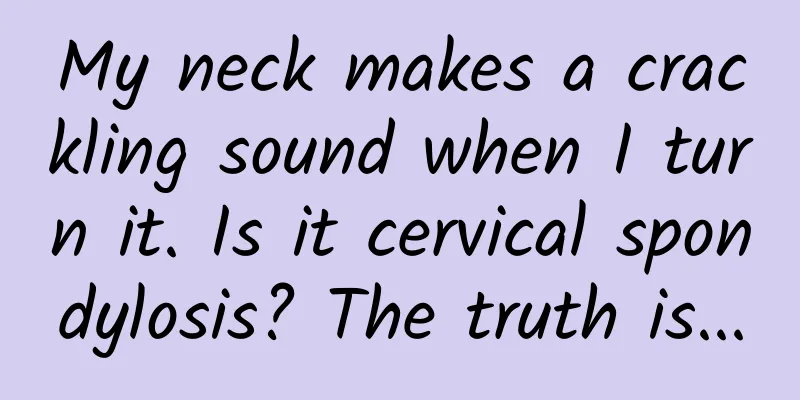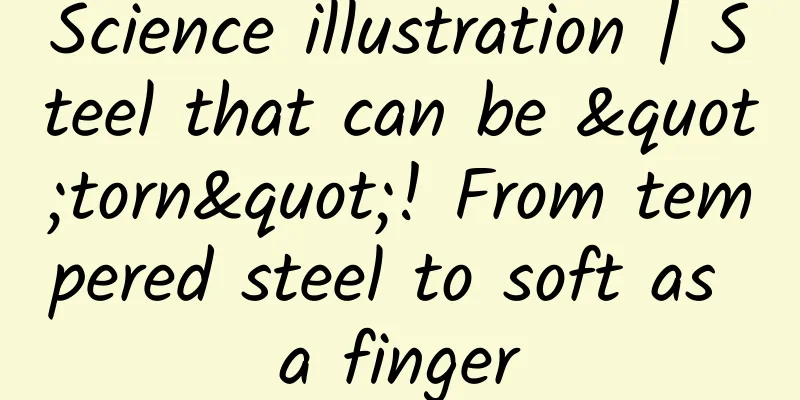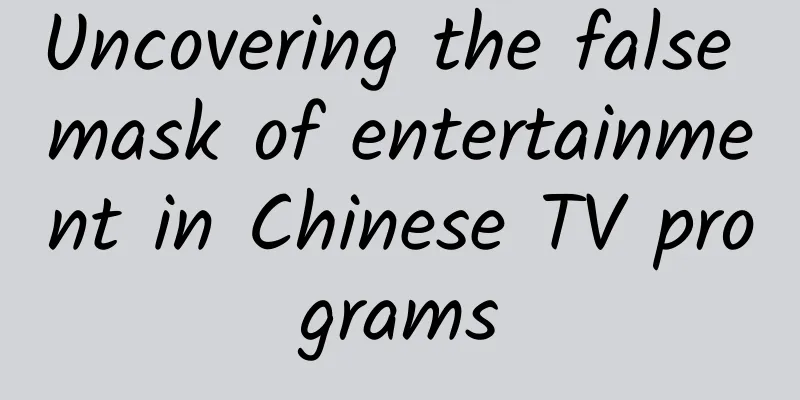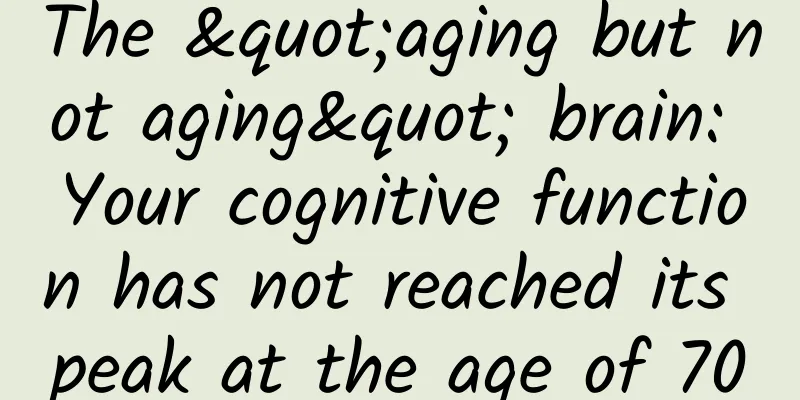My neck makes a crackling sound when I turn it. Is it cervical spondylosis? The truth is...

|
Myth: "If you hear a crackling sound when you turn your neck, you have cervical spondylosis." Many people maintain the same posture for a long time, such as sitting in front of a computer for a long time, looking down at a mobile phone for a long time, etc. If they suddenly turn their necks quickly and hear a "cracking" sound in their neck, they think that there is something wrong with their cervical spine and they have cervical spondylosis. Rumor analysis: Not true. The sound made when twisting the neck is called joint snapping. This sound may be caused by physiological snapping, neck muscle strain, cervical facet joint disorder, etc. If there are no other symptoms, special treatment is usually not required. Therefore, it cannot be judged as cervical spondylosis based solely on the "cracking" sound of the neck. Modern office workers sit in the office and watch computers all day, and their necks are sore and painful. They want to twist and move their necks to make them feel more comfortable. Unexpectedly, when they twist their necks, they make a "cracking" sound. Many people seem to have heard this saying: If the neck makes a "cracking" sound when you move it, it means you have cervical spondylosis. It is inevitable that you will be a little worried. Could I have cervical spondylosis at such a young age? Copyrighted stock images, no reproduction is authorized When I turn my neck, there is a sound. Why? Twisting the neck and making a "cracking" sound is called joint clicking. Except for the cervical spine, all joints in the human body may experience joint clicking. So, what exactly is joint clicking? Body movement is driven by many joints. The larger joints of the human body include the shoulder joint, elbow joint, wrist joint, hip joint, knee joint, etc. The joints are generally composed of articular surfaces, joint cavities and joint capsules. Scientists generally believe that the clicking is the friction between the articular surfaces, between the cartilage pads and the articular surfaces, between the tendons and the joint capsules, or the sound of bubbles or explosions generated in the joints. There are also many small joints in the cervical spine, which can also make clicking sounds. When the cervical spine maintains the same fixed posture for a long time, and then suddenly turns the neck, the friction and collision between the cartilages may cause a "cracking" sound. Does the “cracking” sound in the neck mean there is a problem with the cervical spine? Neck snapping does not necessarily mean that you have cervical spondylosis, and you don't have to worry about breaking your neck. There are two types of snapping sounds from the cervical spine: physiological snapping and pathological snapping. Physiological joint snapping is a crisp, single, painless, popping sound from the joint cavity, which is not a big problem. After a normal adult's joints have been in a static state for a certain period of time, if they are suddenly stretched or flexed and extended, they often make crisp, popping sounds. For example, when the human body suddenly straightens the chest, shrugs the shoulders, opens the mouth, extends and flexes the limbs, twists or extends the trunk after being static for a period of time, the limbs, temporomandibular, and spinal joints often "snap". If you try to make the snapping sound repeat immediately, it is impossible. The joints must be static for a certain period of time before it will reoccur. Although the joints of the spine can occur several times in a row, it is because the spine is composed of multiple joints, and each joint can only make a sound once. This is physiological joint snapping. Copyrighted stock images, no reproduction is authorized Pathological snapping refers to the situation that damage, disease and structural variation inside and outside the joint cause synovial hyperplasia, loosening of joint capsule and ligament, hyperplasia and stenosis of tendon and tendon sheath, and exfoliation of joint cartilage. When the joint moves, the above tissues rub against each other and produce snapping sounds, which are generally dull and frosted. Most of them are accompanied by pain and discomfort, and can occur continuously. For physiological snapping, after turning the neck, you will feel that the soreness and stiffness of the neck are relieved. If it is pathological, after turning the neck, the discomfort of the neck will not be relieved, and there may even be dizziness, tinnitus, numbness of fingers, etc. Common signs of cervical spondylosis If snapping sounds occur and are accompanied by the following conditions, it indicates that you may have cervical spondylosis. 1. Frequent stiff neck If you have a suitable pillow and a correct sleeping posture, but still often have a stiff neck, you should pay attention to it, because it may be caused by an unstable cervical spine and insufficient support from the neck muscles. This is one of the symptoms of early cervical spondylosis. 2. Numbness in fingers If you find that your fingers and forearms are always numb, and sometimes the numbness is more obvious after getting up in the morning, this may also be a sign of cervical spondylosis. 3. Limb weakness The lower limbs are weak, and there is a feeling of walking on cotton when walking. The hands are not flexible and it is difficult to do fine movements, such as: writing is unstable, often buttoning the wrong buttons or being inflexible when buttoning, tying shoelaces, using chopsticks to pick up food, etc. It is difficult. 4. Neck pain persists Neck pain that does not ease due to weather changes, exercise, rest and other factors, but persists, is most likely caused by cervical spondylosis. A small test to check cervical spine mobility If you still can't tell if there is something wrong with your cervical spine, you can also do some simple movements to check the mobility of your cervical spine: 1. Slowly lower your head, slightly retract your chin, and move your chin as close to your chest as possible, and observe whether you can see your belly button. 2. Slowly raise your head and observe whether your eyes can look directly at the ceiling and whether there is any feeling of being stuck at the back of your neck. 3. Gently turn your head to the left and right to see if the tip of your nose can be aligned with the center of your shoulder line, or if your chin can only be turned to the front edge of your shoulder. 4. Tilt your head to the left and right with your nose facing forward, and keep your ears as close to your shoulders as possible. Do not shrug your shoulders and feel whether the neck on the other side is tense. Do these movements in front of a mirror, pay attention to your posture, whether your two sides are symmetrical, whether it is difficult to lower or raise your head, and whether you feel tightness when turning your head. If you feel uncomfortable, you should pay attention to preventing cervical spondylosis. Looking in the mirror of rumors Such rumors often simply and directly link a phenomenon (such as a ringing neck) with a disease (such as cervical spondylosis), ignoring the complexity and diversity of medical diagnosis. This simple attribution method can easily lead people to misunderstand that as long as a certain symptom appears, it must be a certain disease. When faced with such rumors, we should not easily believe unverified information, especially those that are exaggerated or simply attributed. We should be cautious about information and avoid being misled. Author: Deng Ting, attending physician of orthopedics Reviewer: Ji Gang, deputy chief physician of orthopedics, the First Hospital of Hebei Medical University |
<<: Why can rabbits reproduce so quickly? Uncover the amazing survival mechanism behind it!
>>: Sea snake attacks diver, is it because it is "blinded by love"?
Recommend
Apple clears the way for new future strategies; WeChat appreciation function becomes a victim of Cook's ambition
Recently, the Tencent WeChat team helped Apple up...
360 brings in the Coolpad master: How much of a role can he play?
Qihoo 360 invested 400 million US dollars to form...
Witnessing China's smart manufacturing, Emma A7Plus "all the way to god" promotes the high-quality development of the industry
On December 18, the highly anticipated "A7 g...
A conversation with Wannianli CTO Luo Shilong about the programmer's brilliant transformation
[51CTO.com original article] In the Internet indu...
“It’s worth a fortune to be thin in old age”? Not necessarily! Being thin in old age does not mean you are really healthy
There is an old Chinese saying: "A slim body...
Online education: 3 high-growth traffic conversion models
The article summarizes the common conversion mode...
Engineering and cost management from the perspective of the project manager, a compulsory course for improving project manager's ability
Engineering and cost management from the perspect...
Snapdragon 808 global first test: six-core outperforms eight-core Snapdragon 810
LG G Flex 2 was the first in the world to use Sna...
50 financial secrets to comprehensively improve your wealth!
Money is not everything, but it can solve most pr...
How to increase the activation rate of information flow advertising?
How to increase activation volume ? Similar quest...
How long does it take for website SEO optimization to take effect? What to do if website SEO optimization is slow?
How long does it take for website SEO optimizatio...
Credit card interest suspension installment conditions
Credit card interest suspension installment condi...
Top 1000 Mobile Apps with the Most Active Users in October
This article shares with you the TOP 1000 mobile ...
PS4 version of "Call of Duty 13 Infinite Warfare" review: It is criticized and sold fiercely. COD is still the same COD
The Call of Duty series has always been one of th...
Wang, an operator born in the 90s, said: In the new media industry, all KPIs are like a dream bubble!
Have you ever spent a lot of time making so-calle...









